Author: Grayscale Research Team
Translation: Golden Finance xiaozou
Key Points of the Article:
• In July 2025, the price of Ethereum network's ETH token increased by nearly 50%. Investors are focusing on stablecoins, asset tokenization, and institutional adoption—these areas are the key advantages that distinguish this veteran smart contract platform from its peers.
• The passage of the "GENIUS Act" marks a watershed moment for stablecoins and the category of crypto assets. It will take a long time for market structure legislation to pass in the U.S. Congress, but regulators can continue to support the digital asset industry through other policy adjustments—such as approving staking features in crypto investment products.
• While crypto asset valuations may experience consolidation in the short term, we believe this asset class still has a bright outlook in the coming months. Crypto assets not only provide exposure to blockchain innovation but may also mitigate specific risks associated with traditional assets (including the ongoing risk of a weakening dollar). For these reasons, Bitcoin, ETH, and many other digital assets are expected to continue to attract investor interest.
On July 18, 2025, President Trump signed the "GENIUS Act" into law, providing a comprehensive regulatory framework for stablecoins in the U.S. To some extent, the enactment of this legislation can be seen as the "end of the initial phase" for the category of crypto assets: public chain technology is transitioning from the experimental stage to the core of a regulated financial system. The debate over whether blockchain can bring benefits to mainstream users has concluded, and regulators have shifted their focus to ensuring industry development while establishing appropriate consumer protection and financial stability mechanisms.
The crypto market welcomed the passage of the "GENIUS Act," and the favorable macro market environment in July also provided support. Stock indices in most regions of the world rose, and fixed income market returns were led by high-risk sectors, such as U.S. high-yield corporate bonds and emerging market bonds. Strategies benefiting from decreased volatility also performed well. The FTSE/Grayscale Crypto Industry Market Cap Weighted Index—a market cap weighted index of investable digital assets—rose by 15%, while Bitcoin's price increased by 8%. The standout performer was Ethereum's ETH, which saw a 49% increase in July, accumulating over 150% growth since the low in early April.
Chart 1: Overall Performance of Crypto Assets in July, with ETH Shining Brightly
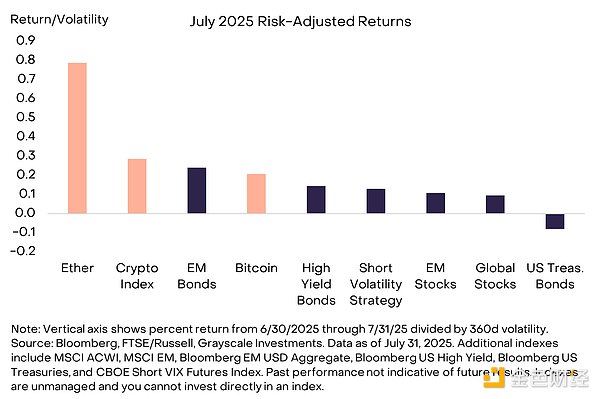
1. Please Do Not Call It a "Rebound"
As the largest smart contract platform by market capitalization, Ethereum is a key infrastructure of the blockchain-based financial system. However, until recently, the performance of ETH significantly lagged behind Bitcoin—and other smart contract platforms like Solana—raising market concerns about its development strategy and competitive position in the industry (Chart 2).
Chart 2: ETH Performance Surpassing Bitcoin Since May
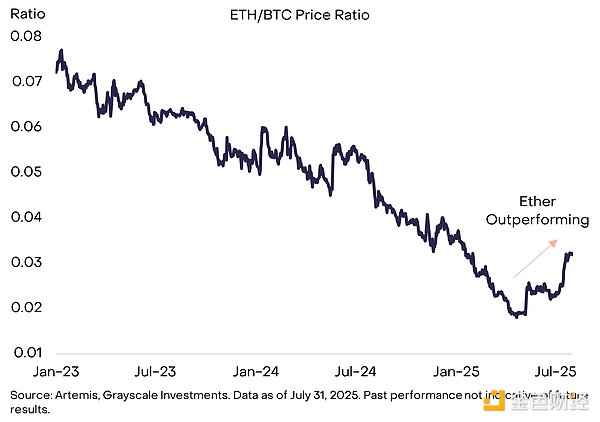
The renewed enthusiasm for Ethereum and ETH likely reflects the current focus on stablecoins, asset tokenization, and institutional blockchain applications—core advantages that distinguish Ethereum from other competing platforms (Chart 3). For instance, when accounting for its layer two networks, the Ethereum ecosystem holds over 50% of the stablecoin balances and processes about 45% of stablecoin transactions denominated in U.S. dollars. The platform also commands 65% of the total locked value in decentralized finance (DeFi) protocols and nearly 80% of tokenized U.S. Treasury products. For institutions like Coinbase, Kraken, Robinhood, and Sony that are venturing into the crypto space, Ethereum remains their preferred underlying network.
Chart 3: Ethereum is the Leading Blockchain for Stablecoins and Tokenized Assets
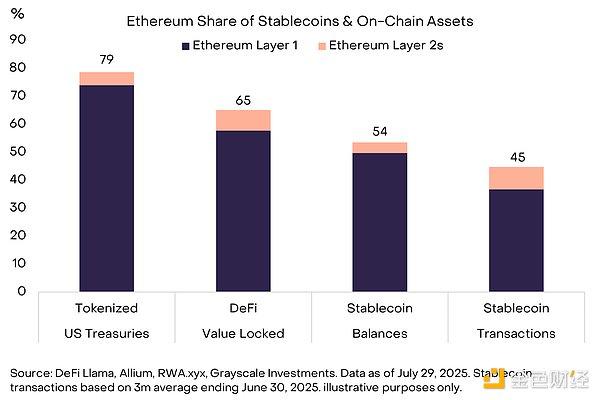
The increase in the adoption of stablecoins and tokenized assets will benefit both Ethereum and other smart contract platforms. Grayscale Research believes that stablecoins are expected to reshape parts of the global payment industry through lower costs, faster settlement speeds, and higher transparency. This involves two types of revenue sources related to stablecoins: one is the net interest margin (NIM) earned by stablecoin issuers (such as Tether and Circle), and the other is the transaction fees earned by the chains processing the transactions. Given Ethereum's leading position in the stablecoin space, its ecosystem is likely to gain higher transaction fee revenues as the adoption of stablecoins increases.
The same applies to the tokenization space—this process aims to bring traditional assets onto the blockchain. Currently, the market size for tokenized assets is still small (approximately $12 billion), but it shows growth potential. Tokenized U.S. Treasuries are currently the largest asset class, with Ethereum dominating this field. In the alternative asset space, Apollo Global recently partnered with Securitize to launch an on-chain credit fund. Although tokenized equity is smaller in scale, it is growing rapidly: Robinhood has launched tokenized stocks for private companies like SpaceX and OpenAI, and eToro has also announced plans for tokenized stocks on Ethereum. Apollo's products support multiple chains, while Robinhood and eToro's tokenized equity products will only be available within the Ethereum ecosystem.
2. ETP Inflows and Their Subsequent Impact
Investor interest in Ethereum has driven significant net inflows into spot ETH exchange-traded products (ETPs). In July 2025, net inflows into U.S.-listed spot ETH ETPs reached $5.4 billion—this is the largest monthly net inflow since the product's launch last year (Chart 4). Currently, the total holdings of ETH ETPs are approximately $21.5 billion (equivalent to nearly 6 million ETH), accounting for about 5% of the total circulating supply of ETH. According to the Commodity Futures Trading Commission (CFTC) "Trader Position Report," we estimate that only $1-2 billion of the net inflow reflects "basis trading" by hedge funds, with the remainder being pure long positions.
Chart 4: Net Inflows into ETH ETPs Exceed $5 Billion
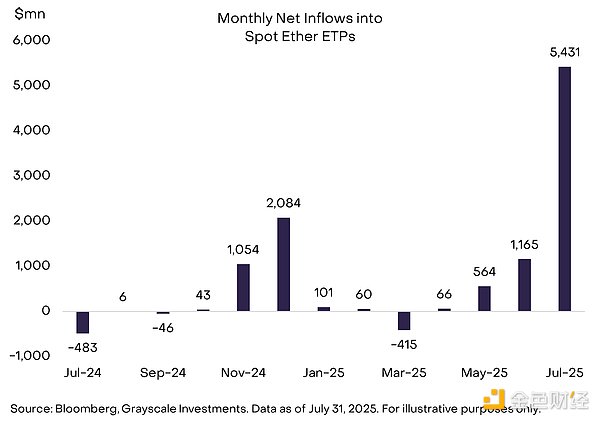
Several publicly listed companies have also begun to increase their holdings of ETH, providing token exposure to investors through equity instruments. The two "crypto asset treasury companies" holding the most ETH are Bitmine Emersion Technologies (stock code: BMNR) and SharpLinkGaming (stock code: SBET). Together, these two companies hold over 1 million ETH, with a total value of $3.9 billion. The third publicly listed company, BTCS (stock code: BTCS), announced in late July plans to raise $2 billion through the issuance of common and preferred stock to increase its ETH holdings (BTCS currently holds about 70,000 ETH, valued at approximately $250 million). In addition to the net inflows into ETH ETP products, buying demand from corporate treasury companies may also have driven the increase in ETH prices.
On the other hand, Ethereum's share in the crypto derivatives market has increased this month, indicating that market speculation interest in this asset is rising. In traditional futures contracts listed on the Chicago Mercantile Exchange (CME), the open interest (OI) for ETH futures has grown to about 40% of Bitcoin (BTC) futures OI (Chart 5). In terms of perpetual futures contracts, ETH's OI has grown to about 65% of BTC OI. This month, the trading volume of ETH perpetual futures also surpassed that of BTC perpetual futures.
Chart 5: Growth of ETH Futures Open Interest

Despite Ethereum's prominence in July, Bitcoin investment products continued to see stable inflows. U.S.-listed spot Bitcoin ETPs had net inflows of $6 billion that month, with current holdings estimated at 1.3 million BTC. Several publicly listed companies have also expanded their Bitcoin asset management strategies: industry leader Strategy (formerly MicroStrategy) issued $2.5 billion in new preferred stock to increase its Bitcoin holdings; Bitcoin early pioneer and Blockstream CEO Adam Back announced the establishment of a new Bitcoin asset management company, Bitcoin Standard Treasury Company (stock code: BSTR), which will use Bitcoin held by Back and other early adopters as its capital base while also engaging in equity financing. BSTR's operating model is highly similar to the SPAC (Special Purpose Acquisition Company) transaction previously designed by Cantor Fitzgerald for Twenty One Capital—this latter was a Bitcoin asset management company supported by Tether and SoftBank.
3. The Altcoin Boom
In July, valuations across all sectors of the crypto market rose significantly. From the perspective of crypto industry classification, the best-performing sector was the smart contract sector (benefiting from ETH's 49% increase), while the weakest was the artificial intelligence sector (dragged down by the weakness of certain tokens) (Chart 6). In the same month, the open interest and funding rates (the cost of financing leveraged long positions) of most crypto assets rose in tandem, indicating an increase in investor risk appetite and speculative net long positions.
Chart 6: The Crypto Market Rose Across the Board in July
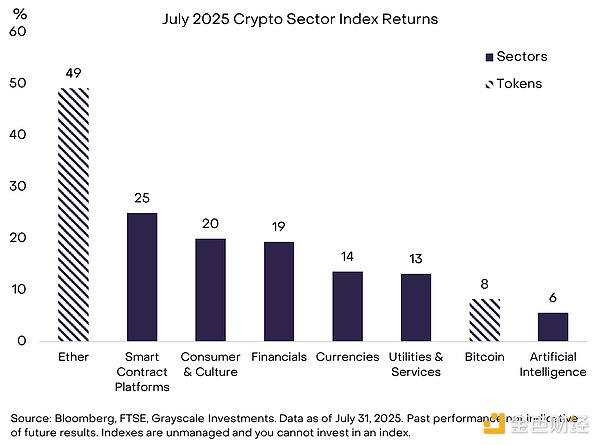
After experiencing a strong return cycle, there is always a risk of valuation pullback or consolidation. The passage of the "GENIUS Act" has provided a significant positive catalyst for the category of crypto assets (which explains the dual strong performance in absolute returns and risk-adjusted returns), but the legislative drive may weaken in the short term. While the U.S. Congress is currently reviewing crypto market structure legislation (the House version, the "CLARITY Act," was passed with bipartisan support on July 17), the Senate is still advancing its own version, and substantial progress is unlikely before September.
Nevertheless, we remain optimistic about the outlook for this asset class in the coming months. First, regulatory dividends can continue to be released without legislation: a recent special report on digital assets released by the White House proposed 94 specific development recommendations (60 of which fall under the jurisdiction of regulatory agencies, while the remaining 34 require congressional or interdepartmental collaboration). Second, regulators can enhance investment tools by approving staking features and expanding the product matrix of spot crypto ETPs, continuously guiding incremental capital into the market.
Additionally, we expect the macro environment to continue to favor crypto assets—these assets can provide exposure to blockchain innovation while mitigating specific risks associated with traditional assets. In addition to signing crypto-related legislation in July, President Trump also signed the "OBBBA Act" (One Big Beautiful Bill Act), which institutionalizes the federal government's massive budget deficit for the next decade. Trump has also explicitly stated his desire for the Federal Reserve to lower interest rates, emphasizing that a weaker dollar would benefit U.S. manufacturers and imposing tariffs on various products and trade partners. The massive budget deficit and lower real interest rates may continue to suppress the value of the dollar, especially with the White House's tacit approval. Scarce digital commodities like Bitcoin and ETH may benefit from this environment and can serve as partial tools to hedge against the ongoing risk of a weakening dollar in investment portfolios.
免责声明:本文章仅代表作者个人观点,不代表本平台的立场和观点。本文章仅供信息分享,不构成对任何人的任何投资建议。用户与作者之间的任何争议,与本平台无关。如网页中刊载的文章或图片涉及侵权,请提供相关的权利证明和身份证明发送邮件到support@aicoin.com,本平台相关工作人员将会进行核查。




